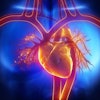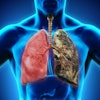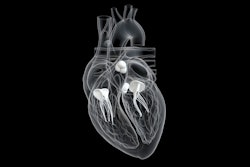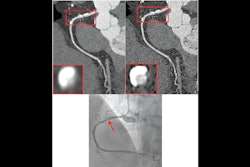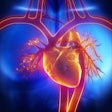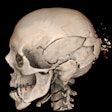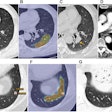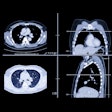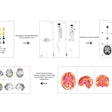AI-assisted reading using a deep-learning algorithm boosts reader agreement for cardiac CT angiography (CCTA) CAD Reporting and Data System (CAD-RADS) classification, according to a study published October 9 in Radiology: Cardiothoracic Imaging.
The results suggest that "the use of [deep learning] to automate CAD-RADS evaluations holds a potential to further reduce variability and optimize the goal of standardizing reporting," wrote a team of investigators led by Roberto Farì, MD, of Emory University in Atlanta, GA.
CCTA is a commonly used technique for evaluating patients with coronary artery disease (CAD), but wide variability is found in both reporting CCTA results and interpreting them. The CAD-RADS framework standardizes CAD evaluation, but remains "prone to interpretation and classification errors," the authors explained. That's where deep learning can help, they wrote.
To assess the technology's potential for this use, Farì's team conducted a study that included 623 patients (371 men, mean age, 55) who underwent CCTA between January 2010 and December 2019. One radiologist analyzed the scans both manually and with deep learning-assisted reading at the lesion, coronary segment, and patient levels using CAD-RADS; the AI algorithm also identified, quantified, and classified coronary lesions on its own. Similarly to the first reader, a second reader assessed a randomly selected subset of 274 exams. Finally, a set of CAD-RADS scores from 362 CCTA reports was used for comparison and categorized as "reader three."
The final study sample included 11,214 coronary segments analyzed from the cohort of 623 patients. Of these, 295 (47.9%) had no coronary artery disease (CAD-RADS 0), 213 (33.6%) had low risk of disease (CAD-RADS < 3), and 115 (18.5%) had high risk of disease (CAD-RADS ≥ 3).
AI assistance improved CAD-RAD agreement between reader one and both readers two and three:
Interreader agreement evaluated by manual and AI-assisted reading for CAD-RADS categorization | ||
Readers | Manual readings | AI-assisted readings |
| 1 vs. 2 | 73.7% | 81.8% |
| 1 vs. 3 | 77.9% | 84.5% |
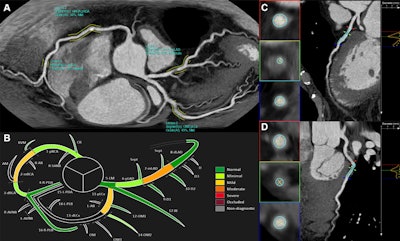 AI reconstruction. (A) Two-dimensional overview of the whole coronary tree obtained from CCTA, as reconstructed by the software. Areas of stenosis are highlighted and visualized together with an esteem of lumen diameter and area reduction, as well as the corresponding CAD-RADS stenosis grade. (B) In another reconstruction, all 18 segments are displayed and colored based on the esteemed CAD-RADS stenosis grade. (C, D) The software provides additional images for each detected lesion, with specific reconstructions to show the reader the exact lumen diameter and stenosis grade. CAD-RADS = Coronary Artery Disease Reporting and Data System, CCTA = coronary CT angiography. Images and caption courtesy of the RSNA.
AI reconstruction. (A) Two-dimensional overview of the whole coronary tree obtained from CCTA, as reconstructed by the software. Areas of stenosis are highlighted and visualized together with an esteem of lumen diameter and area reduction, as well as the corresponding CAD-RADS stenosis grade. (B) In another reconstruction, all 18 segments are displayed and colored based on the esteemed CAD-RADS stenosis grade. (C, D) The software provides additional images for each detected lesion, with specific reconstructions to show the reader the exact lumen diameter and stenosis grade. CAD-RADS = Coronary Artery Disease Reporting and Data System, CCTA = coronary CT angiography. Images and caption courtesy of the RSNA.
The study results are promising, but more research is needed, according to the investigators.
"Future studies should test AI-assisted reading on larger, more robust datasets with consistent and overlapping expert annotations," they concluded. "They should also assess its clinical impact, real-time performance across diverse settings, and potential role in training less experienced readers."
The complete study can be found here.


